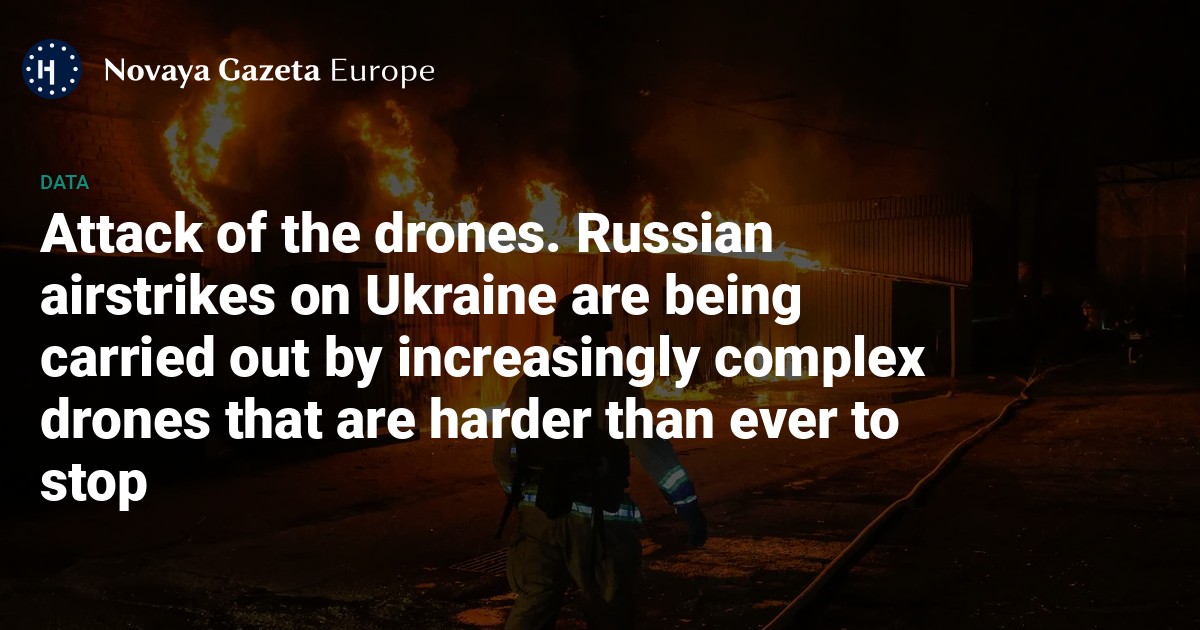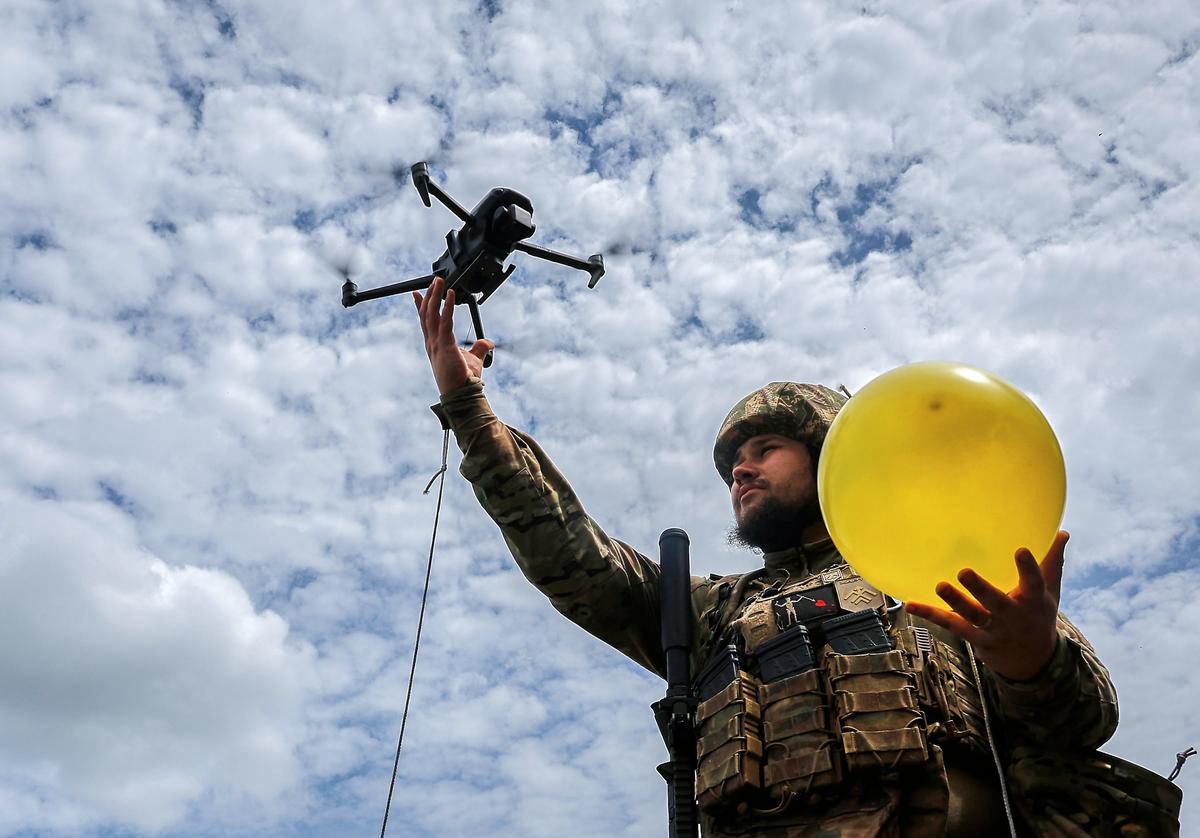



Russia launched its largest single drone attack of the war against Ukraine’s cities on 1 June, when the Ukrainian Air Force reported that they faced 472 one-way attack (OWA) drones overnight.
That record may not stand for long, however — the prior one was set on 26 May, when Moscow launched 355 drones at its neighbour, though the day before that saw Russia set a new record when it launched 298 Shahed drones, surpassing a previous record set on 18 May.
Though Russia’s enormous OWA drone strikes may have come as a surprise to both politicians and the general public, they’re the culmination of years of work by the Russian military. After Initially purchasing Shahed drones from Iran, in 2023 Russia began building factories to assemble and then manufacture the Iranian-designed drones in Russia. Greater control over their production has given Russia the opportunity to increase the number of Shaheds it makes quickly.
It also allows them to upgrade their drones gradually. Investigations into downed Shaheds show that Russia has been coating its drones in carbon, which resists detection by radar by absorbing incoming waves instead of reflecting them back. They have also been adding SIM cards to transmit data back to Russia through mobile networks.

A Ukrainian serviceman lifts a drone attached to a balloon for target practice during anti-drone training at an undisclosed location near the frontline in the Kharkiv region, northeastern Ukraine, 30 May 2025. Photo: EPA-EFE/SERGEY KOZLOV
Russia has also upgraded the warheads it arms its drone with. On 20 May, Ukrainian media reported that Shaheds were using newer incendiary and fragmentation warheads, which increase the destructive impact of a drone strike by starting fires and spreading large volumes of shrapnel respectively.
These upgrades were kept simple in order to ensure that Russian military drones remain relatively low cost — their major advantage over missiles — with the result that Russian drones are now both inexpensive and long-range.
This means that Russia can launch hundreds of drones every month at targets across Ukraine with little concern for how many are lost along the way. Meanwhile, Kyiv is stuck figuring out how it can intercept all incoming drones indefinitely at a reasonable cost.
Despite Ukraine’s evolving air defence, Russia still sees military benefits to constant Shahed attacks.
The problem is made even more complicated by the fact that Ukraine desperately needs its insufficient number of air defence systems at the front line to shoot down enemy aircraft, making the decision about whose needs to prioritise a difficult one.
Adding to the problem is the recent production of decoy Shaheds, drones that pose little threat by themselves as they carry no warhead, but which Ukrainian air defence systems cannot always differentiate from the real thing. In late May, Ukrainian officials told the media that up to 40% of incoming Shaheds were decoys.
Consequently, Moscow’s 472-drone attack showcases all the Russian military’s innovations to date, with an increased number of drones reaching their targets due to the use of decoys and translating into an overall increase in lethality.
Ukraine shoots most incoming Shaheds down. Even the 472-drone attack still had 382 claimed interceptions, a rate of 81%. However, the relatively high interception rate masks the benefits of drone warfare for Russia.
Shaheds are cheap by military standards, so by launching near-constant attacks, Moscow is placing a disproportionate burden on Ukrainian air defence units. Kyiv has mobilised an enormous amount of resources to protect its cities, from mobile units in trucks to counter-Shahed drones that function much like anti-aircraft missiles but are far less expensive.
That said, these systems often have short ranges, which means that the savings per interception are somewhat offset by the need to maintain many hundreds of systems across a country as large as Ukraine. Kyiv also has the option of trying to strike Russia’s Shahed factories, which they have attempted a few times.
Putin has shown a determination to expand the scale and tempo of his drone campaign and resist Ukraine’s calls for a permanent “ceasefire in the sky”
Despite Ukraine’s evolving air defence, Russia still sees military benefits to constant Shahed attacks. In a study I contributed to last year, we found that Russia’s initial OWA drone strategy in 2022 and 2023 did little to force Ukraine to the negotiating table. That may still be the case now, but the volume of drones and the high tempo of attacks means that Russian strategy could well be aimed at systematically exhausting Ukrainian air defence.
As Ukraine grapples with unpredictable US military support, Kyiv is more vulnerable to running out of ammunition for its more advanced air defence systems. This means that constant Shahed attacks make it more difficult for Ukraine to stop incoming missiles, which carry much larger warheads.
Of course, Ukraine has its own version of the Shahed, which it routinely uses to strike Russian military and oil facilities. Less is known about Ukraine’s OWA drones, but they tend to use similar features to those used in Shaheds, such as satellite navigation.

A woman watches Russian military drones taking part in celebrations for Victory Day in Moscow, 3 May 2025. Photo: EPA-EFE / SERGEI ILNITSKY
For Russia’s Vladimir Putin, using Shaheds is not all about military benefit. Politically, he has increasingly used drones to project a sense of power to his domestic audience. On 9 May, Russia for the first time paraded Shaheds through the streets of Moscow as part of its annual Victory Day celebrations.
Ukraine has begun employing its own OWA drones as part of Operation Spider’s Web , which saw it attack military and oil infrastructure across Russia last Sunday.
Russia’s 472-drone strike is unlikely to remain its largest attack for long, as Putin, determined to resist Ukraine’s calls for a permanent “ceasefire in the sky”, is likely to expand the scale and tempo of Russian drone strikes. However, Ukraine’s drone strategy in the past week has shown that prolonging the drone war can also have serious and unexpected effects for Moscow.
As long as the conflict continues, Ukraine’s defenders will find themselves facing more, and better, drones aimed at their cities. But increasingly it looks like Russia must worry about Ukraine’s drone capabilities too.
Marcel Plichta is a former intelligence analyst for the US Department of Defence and a current PhD candidate in the School of International Relations at the University of St Andrews. This article was first published by The Conversation.
The Russian government has banned independent media. We were forced to leave our country in order to keep doing our job, telling our readers about what is going on Russia, Ukraine and Europe.
We will continue fighting against warfare and dictatorship. We believe that freedom of speech is the most efficient antidote against tyranny. Support us financially to help us fight for peace and freedom.
By clicking the Support button, you agree to the processing of your personal data.
To cancel a regular donation, please write to [email protected]
VPNovaya
Help Russians and Belarusians Access the Truth
